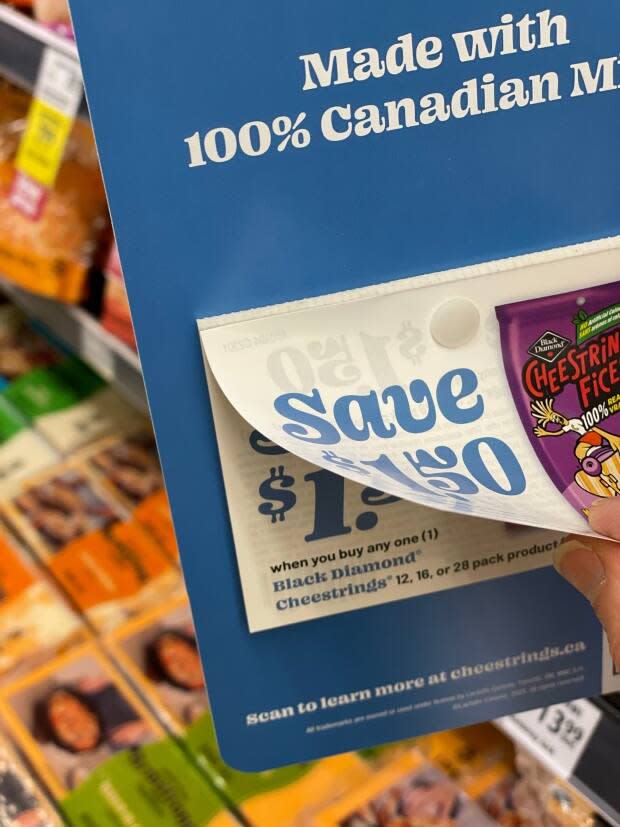Want to save money at the grocery store? Shop your freezer and pantry first

Amanda Drescher knows what it's like to have to stretch her food budget.
The Clearwater, B.C., woman first started to figure out techniques to save money when her husband was laid off, and she had just started her maternity leave.
"All we had was my EI, which worked out to be $14 above the mortgage every two weeks, so we went through our savings real quick."
She went online to find out ways to save money but couldn't find the types of practical tips she was looking for. That led her to compile her own list of resources.
Now she has taken that knowledge and teaches others as part of workshops intermittently run through Yellowhead Community Services.
With food prices sometimes climbing more than 10 per cent monthly, many people are looking for ways to save when they fill up their carts.
The 2023 forecast from Canada's Food Price Report — an annual publication by Canadian researchers taking stock of food pricing trends — predicts Canadian families will spend up to $1,065 more on food in the next year.
Rick Barichello, a professor at the University of British Columbia's faculty of land and food systems and one of several contributors to the report, said 2022 saw some of the highest price increases for consumers in decades.
"Inflation on food prices was much higher than was anticipated and worst of all, it still seems to be at fairly high rates," he said, though researchers are predicting a slight decrease as the year moves on.
According to Sylvain Charlebois, the director of Agri-Food Analytics Lab at Dalhousie University and project lead for the annual report, increases in food prices will likely continue at least until spring or summer, so people need to be prepared to manage hikes in their food bills.
He said it takes time for policy to reduce food inflation, and even then, it's not always clear whether changes will result in the desired reduction in rates. However, he said as long as things don't change significantly on a global scale, price increases should slow down in about six months.
Ways to save on food prices
Shop your pantry and freezer first
Drescher suggests that the first place people should start is making an inventory of what's already in the pantry or freezer.
"There are things that you have forgot about, I promise."
By planning meals with food that is already purchased, she says people can reduce food waste and spending.
She also suggests putting a list on chest freezers to quickly track what's there and reorganizing the fridge, so the most perishable items are also the most visible.
Track your spending
Before heading to the grocery store, Drescher said people should go through their last three months of bank statements and credit card bills to track food spending.
"Make sure that you are giving yourself an honest number, and then when you start to see that number go down, it's really encouraging," she said.
A few dollars here and there might not seem like a lot, but it could add up to hundreds over time, she added.
Learn the sale cycles
According to Drescher, every six to eight weeks, items tend to go on sale.
She said knowing when items are cheapest will let consumers figure out when something is too expensive.

She recommends stocking up on well priced items where possible and combining those sales with coupons to get the best price.
Look for price-matching opportunities
Many stores will price match other stores' sale prices, so Drescher said it's worth keeping track of prices and bringing those flyers to the till.
However, it's worth noting that stores will only match prices on the exact items that are advertised.
Learn the apps (not just price-tracking ones)
Many of the more serious savers told CBC that they use online free apps as a big part of their grocery routine.
In her food-saving class, Drescher tells people about a number of free apps that work well in B.C., including the Flipp app, which publishes flyers once a week in a searchable format, the Flashfood app, which sells food approaching the best-before dates at select stores and the Checkout 51 app, which lets people earn cash back for sharing their receipts.
Team up on bulk buys
Another thing consumers can do is buy in bulk.
Merritt-area farmer Shealynn MacVicar said if people are overwhelmed by the volume, they can team up with friends or family to divvy up the food.
"You'll get a way better price on your food," MacVicar said.
She also says local food is often fresher, which can lead to less spoilage and food waste.
Ignore the best-before date
Charlebois has done research into food waste and said one of the biggest causes is best-before dates.
He said while the dates are an indication of freshness, it doesn't mean the food is bad after that date and is often worth eating.
"Don't throw it out. Just use your senses to assess, and that is certainly one way to save money," he said.
Consumers should note that there is a big difference between expiry dates and best-before dates and not consume items that pose a potential health risk, including things like spoiled foods, meal replacements and liquid diet products.
Too expensive, don't buy it
Charlebois also encourages people to only buy an item when they think the price is reasonable.
"If you see something that you feel is overpriced, just walk away and buy something else, and for grocery stores, that's data [that retailers pay attention to]."
He says retailers use that information to adjust their pricing to maximize sales.
"Your decisions make price point differences for how things are priced."



